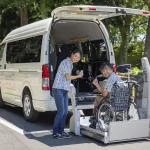Getting a Taxi
Taxis are fairly easy to find in Japan, especially in tourist areas. Around major train stations, you will see Taxi ports where the available Taxis cue up for customers. In town, if you see a cab with a red lamp (空車), which means they are available to pick you up. That being said, you may need a specific type of cab that can accommodate a wheelchair, or lots of luggage.
You can either call ahead from your hotel, or use the Japan Taxi app if you have a smartphone. The Japan Taxi App allows you to pay using a credit card, and covers various regions in Japan. Another useful app is Navitime, it has maps and travel guides that are helpful for navigating.
- Nihon Kotsu: In additional to regular taxis, they offer a service called “support taxi” with drivers that are trained to assist wheelchair users, but this part of website is in Japanese only.
- Tokyo Taxi Center: public organization offering information on taxis.
- English Drivers
- Tokyo Taxi-Hire Association
- JNTO
- Tokyo Tours: You can hire a private ride and guide to take you around.
- Oshidori-Shuttle Tokyo: A wheelchair taxi that can drive directly to a destination or tour.
Paying Taxi Fare and Tips
Although digital currencies are becoming quite popular, Japan is still a heavily cash based economy. It is a good idea to carry cash with you, as some cabs may not be equipped to take a credit card. Japan does not have a personal check system as in the US. Note: when using a credit card at stores, you may be asked if you would like to pay “Ikkatsu” (one-time) or break up your payment.
Fees for a cab are metered and currently start at 410 yen initially. Fees increase approximately 200-400 Yen per kilometer. There is a 20% increase in fees for late night (10PM – 5AM). However, it is standard that riding from the airport consists of a set fee cabs to certain locations.
Japan does not have a tip culture and service fees are included within pricing. The current consumption tax rate is 8% nationwide, and will become 10% from October 2019 (excluding some items such as groceries). In Tokyo, Kyoto and other tourist heavy locations there are some stores which have a Tax Free sign that will exempt the sales tax for travelers if you show your passport. They usually require you to go to a special desk, and sometimes you cannot unseal your bag of goods until they are checked at the airport as “Duty Free”.
Fare Finder Links: taxifarefinder.com and japantaxi.jp
Wheelchair Support
According to the driver, the Toyota manufactured cabs (JPN taxi) are capable of transporting 1 wheelchair user and 1 other adult passenger. The drivers have a slope ready to attach to the car to assist in boarding. Video of how wheelchairs board and are secured in a Toyota manufactured JPN Taxi.
One thing to note is that for a wheelchair to board a taxi, there needs to be enough surrounding space. Japan is a small country that has narrow roads, so when planning a trip with a wheelchair user, be sure to consider where you will be boarding/disembarking from the taxi so that you have enough space. The taxi drivers and companies are very courteous and should be able to help with this planning.


















We run a care taxi business in Tokyo area too.
It would be appreciated if we can become a member of the service provider.
http://www.oshidori-shuttle.tokyo
Yes! Let’s get you on the website. Please email me at info@wheelchairtraveling.com.